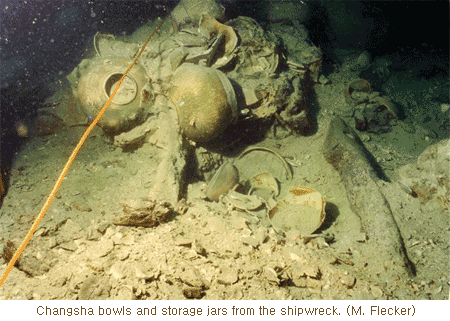Another Smithsonian debate: Should the Sackler Gallery show artifacts from a commercially excavated shipwreck?
In a few weeks the Smithsonian Institution and its Freer Gallery of Art and Sackler Gallery will decide whether to show the rare bounty that was excavated by a commercial enterprise in the shallow waters off Indonesia.
The center of the debate is the Belitung shipwreck that was excavated in 1998 by a salvage company, under the authorization of the Indonesian government. This action has been condemned by some authorities in the underwater archeology field as a breach of scholarly guidelines.
Contained in the ancient Arab ship were approximately 60,000 objects, mostly ceramics from the Tang Dynasty, considered a treasure trove and a window into the methods of Chinese ceramics and the country’s interaction with other traders in the 9th Century.
Besides the importance of the artifacts, the museum wants to mount the exhibition as a way of opening up a conversation on underwater cultural heritage, and all the complex questions surrounding that preservation. Julian Raby, the director of the Freer and Sackler, says the salvage was legal but there is room to discuss whether it was ethical. One of the advantages of the salvage is that the cargo was kept largely intact.
And it is historic, says Raby, giving solid evidence of the trade between the Islamic world and China and proving there was a maritime silk road, as well as an overland one.
“This is truly amazing material. It is material that completely changes the way we begin to view what happened in the 9th century,” Raby said, whose museums are a co-sponsor of a tour of the artifacts.The shipwreck show is penciled in for next spring at the Sackler.
On these questions Raby and Smithsonian Secretary G. Wayne Clough, have been getting plenty of advice. This week Raby called a meeting at the Smithsonian to hear from various critics and supporters that lasted four hours.
“Everyone in the room wished it had been excavated differently,” said Kaywin Feldman, president of the Association of Museum Directors and president of the Minneapolis Institute of Arts. “As museum people we believe in the strength of real objects to tell a story.”
Ford Bell, president of the American Association of Museums, said the meeting was “an important one to have.’’ Bell understands the objections because of the collection methods and commercial sale. “It was a commercial transaction, which is a no, no. But this is one of the most important discoveries over the last 50 years. I don't think we can miss the chance to tell this historic story. We can create a teachable moment.”
“These has immense implications for global history. It is not about the pots but how China opened up,” said archeologist Richard Hodges, the director of the University of Pennsylvania Museum of Archeology and Anthropology. Hearing all the arguments, he said, “I came away strongly convinced that the Smithsonian should stand up and be counted. As a world museum, it can illustrate how this area of study can be better understood. They must be bold.”
In a letter to Clough, the International Committee for Underwater Cultural Heritage said the recovery of the materials was primarily for “commercial exploitation.” “Opposition to these ventures is greatly weakened if institutions with the standing of the Smithsonian mount exhibitions of such material. Effectively this support aids and abets the continuation of a practice that has won widespread condemnation,” said the organization’s president, Thijs. J. Maarleveld.
The Council of American Maritime Museums also wrote Clough that the organization objected to the why the underwater salvaging was done and the disposition of the items. “For the Smithsonian to be associated through this exhibit and display materials from this site would appear to support the commercial exploitation of our international maritime heritage,” its president, Walter Rybka wrote. “It could set back the maritime preservation movement in fundamental and significant ways.”
Often the critics cite the standards set by the UNESCO Convention on the protection of cultural property. Neither Indonesia nor the United States are signatories to the agreement.
Mark Horton, an archeologist at the University of Bristol, argued in a letter to Raby: “I am fully aware that the cargo was recovered in a manner that may not compare to the highest current standards of maritime archaeological practice. However.....I am satisfied that this was the only way that the cargo could have been recovered, and the structure of the associated shipwreck to be studied in situ.” The artifacts were transported from Indonesia to New Zealand and Germany for conservation before most of the lot was sold to the Singapore government. On display now in Singapore where officials plan to display it permanently in a public museum.
Michael Flecker, an internationally known maritime archeologist, supervised the second excavation in 1999. “The bulk of the material was excavated in the first year. That was done. We shouldn’t deprive the public of this story,” said Feldman.
Jessica Rawson, professor of Chinese art and archaeology at the University of Oxford, wrote Raby that an ancient find would inform the current geopolitical world. “If...we enable a wider public to explore, through such exhibitions as ‘Shipwrecked,’ the depths of China’s history, the complexities of China will be understood by more people than before and they will be better prepared to meet positively the development of this major power,” Rawson wrote.
